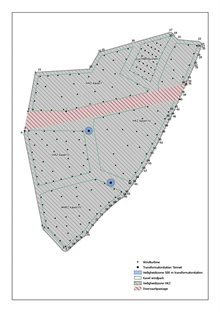Through Shipping
Whether or not vessels may pass through a wind farm depends on the rules for the wind farm. These are included in a code of conduct for each wind farm. Passage-ways or corridors for through shipping may be designated: fairways through which vessels can pass in both directions. In the context of MOSWOZ, Rijkswaterstaat is investigating the risks of allowing shipping to pass through wind farms compared with diverting around them.
The studies below were carried out in the context of policy support advice for DGLM and also provide relevant information for the MOSWOZ theme Transit.
The following research questions have been determined for the topic of Through Shipping:
- Is endeavouring to facilitate through shipping beneficial or not in terms of shipping safety?
- How can you characterise the interaction between vessels (entering/leaving/crossing shipping lanes) that sail around wind farms and those that sail through the wind farms?
Shipping passage-way and corridor studies
Engineering consultancy Movares conducted studies into what constitutes a suitable, safe width for shipping passage-ways and corridors (PDF, 2.3 MB) in 2022. In the case of a passage-way or corridor without obstacles, the researchers recommend a minimum width of 1160 metres. They also recommend a 3-zone model, in which zone 1 represents the 'normal' fairway, zone 2 is intended for special operations and zone 3 is closed to all traffic. The report also expresses the expectation that wind turbines will get bigger, while the corridors and passage-ways will get busier. As a result, the researchers recommend maintaining a greater width than the proposed minimum if possible.
The Maritime Research Institute Netherlands (MARIN) also conducted research into the effects of passage-ways and corridors on shipping safety in 2021(PDF, 15 MB). The research analyses the risks of collisions: between two vessels, collisions with platforms and with wind turbines. Where passage-ways and corridors for vessels have been introduced, the number of expected accidents falls in relation to a situation in which free (unrestricted) passage is permitted. This is a result of the drop in the number of expected collisions between vessels and wind turbines. An exception is made for wind turbines along the edges of passage-ways and corridors, and to the north and south of wind farms. In such places, shipping traffic does, in fact, increase in relation to a situation without passage-ways and corridors.

Shared use studies
Studies into through shipping often also assess the potential for shared use, as through passage is not possible where there is shared use and vice versa. 'Shared use' here means other activities in wind farm zones, such as seaweed cultivation or the generation of solar power. Activities of that kind imply safety hazards. Can the installations in the wind farm zones be seen clearly in all weather conditions, for example? And what sort of hazards does shared use pose to shipping?
In 2022 and 2023, MARIN researched the maritime hazards in relation to shared use of offshore wind farms (PDF, 3 MB), such as the risk of a collision between a vessel and an installation for shared use. The MARIN research produced an overview of hazardous situations with three sorts of shared use: mussel aquaculture, seaweed cultivation and the generation of solar energy. An important conclusion is that the consequences of collisions involving moving or drifting objects are still unknown.
MOVARES also conducted research into shipping safety in relation to shared use and through passage in 2023. The results of this research are expected to be published in the first quarter of 2024.